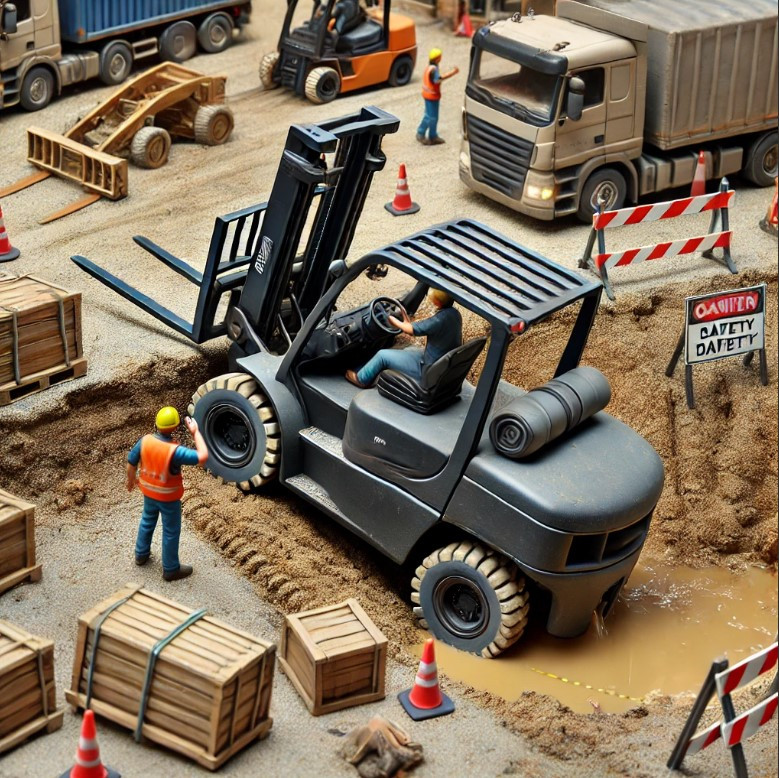Rough terrain forklifts are essential in construction sites, lumber yards, agricultural settings, and outdoor warehouses, where uneven ground, slopes, and unpredictable conditions make material handling more challenging. Unlike standard warehouse forklifts, rough terrain forklifts are designed for stability and durability in harsh environments. However, operating them without proper training can be extremely dangerous.
At Get Drivers Ed, we emphasize the importance of proper forklift training to prevent accidents, protect operators, and ensure compliance with OSHA regulations. In this guide, we’ll explore the hidden dangers of rough terrain forklifts and why forklift certification and training are critical for safety.
Understanding Rough Terrain Forklifts and Their Challenges
1. What Makes Rough Terrain Forklifts Different?
Unlike indoor forklifts, rough terrain forklifts are designed with:
Larger, Pneumatic Tires – These heavy-duty tires provide better grip on uneven surfaces like dirt, gravel, and mud.
More Powerful Engines – Rough terrain forklifts often have diesel or gas-powered engines to handle heavier loads.
Higher Ground Clearance – This feature allows for better maneuverability on slopes and rocky terrain.
Four-Wheel Drive Capabilities – Helps the forklift stay stable in wet, muddy, or slippery conditions.
While these features make rough terrain forklifts ideal for outdoor work, they also introduce new risks that operators must be trained to handle.
2. The Hidden Dangers of Operating Rough Terrain Forklifts
Without proper training, operating a rough terrain forklift can lead to serious injuries, equipment damage, and even fatalities. Some of the most significant dangers include:
Uneven Ground and Tip-Overs
The biggest risk when using a rough terrain forklift is tipping over due to uneven surfaces, slopes, or carrying unstable loads.
Operators must learn how to properly balance loads and navigate inclines safely to prevent rollovers.
Load Instability and Falling Objects
Improperly stacked or unbalanced loads can fall, injuring the operator or workers nearby.
Training teaches operators how to properly distribute weight and secure loads.
Limited Visibility in Outdoor Environments
Unlike warehouse forklifts, rough terrain forklifts often work in crowded, high-risk areas with limited visibility.
Operators must know how to use mirrors, signals, and spotters to prevent collisions.
Slippery and Wet Surfaces
Outdoor job sites can become muddy, icy, or flooded, making forklifts more difficult to control.
Training helps operators understand how to adjust speed and braking techniques in these conditions.
How Forklift Training Keeps Operators Safe
At Get Drivers Ed, we offer comprehensive forklift training programs that teach operators how to safely and effectively use rough terrain forklifts.
3. Essential Skills Taught in Forklift Certification Training
To safely operate a rough terrain forklift, drivers must master several critical skills.
Proper Equipment Inspection
Before every shift, operators must conduct a pre-operation inspection, checking:
Tire pressure and condition
Brakes and steering controls
Hydraulic and fuel systems
Lift mechanisms and attachments
Safe Load Handling and Weight Distribution
Operators learn how to balance and secure loads properly to prevent tip-overs.
Training covers how to use counterweights, mast tilting, and load limits effectively.
Navigating Rough Terrain Safely
Drivers practice maneuvering on gravel, slopes, and wet surfaces.
Training includes adjusting speed, using four-wheel drive, and handling inclines.
Emergency Response and Accident Prevention
Operators learn how to handle equipment malfunctions, avoid collisions, and respond to forklift accidents.
Training emphasizes defensive driving techniques to improve workplace safety.
4. OSHA Requirements and Why Certification Is Essential
Why OSHA Requires Forklift Certification
OSHA’s regulations (29 CFR 1910.178) require all forklift operators to complete proper training and certification before operating any type of forklift.
Employers that fail to comply with OSHA standards can face heavy fines and liability issues in case of accidents.
How to Get Certified with Get Drivers Ed
At Get Drivers Ed, our forklift certification program includes:
Classroom Training – Covers OSHA safety regulations, hazard awareness, and forklift mechanics.
Hands-On Training – Teaches real-world forklift operation in outdoor conditions.
Final Certification Test – Ensures operators meet OSHA’s safety and performance standards.
By completing certification training at Get Drivers Ed, forklift operators increase their job opportunities, workplace safety, and compliance with federal laws.
Conclusion: Protect Yourself and Your Workplace with Forklift Training
Rough terrain forklifts are essential for outdoor job sites, but without proper training, they pose serious risks. From tip-overs and unstable loads to navigating uneven terrain, operators must be trained and certified to prevent accidents and injuries.
At Get Drivers Ed, we offer OSHA-compliant forklift certification programs designed to equip operators with the knowledge and skills to handle rough terrain forklifts safely and efficiently.
Don’t take unnecessary risks—get trained today! Enroll in our forklift certification course at Get Drivers Ed and take the first step toward safer forklift operations!


